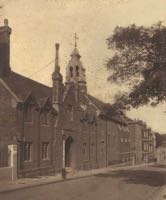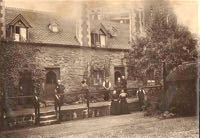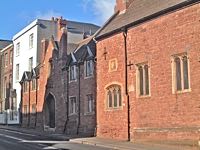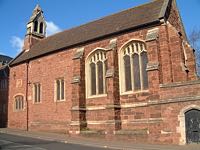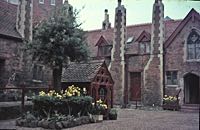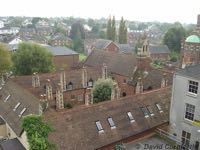
Wynards Almshouses
Page updated 16th February 2015
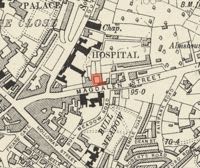 William Wynard (also Wonard or Wenar), who was Recorder (lawyer) of Exeter between 1404-1442 founded his "Godshouse"; or "almeshous," in Magdalen Street on 20 January 1436. He also founded the attached chapel of the Holy Trinity and
Maison Dieu. It was to house a priest and twelve infirm or poor men. He placed it under the supervision of the Mayor and twelve citizens of the city. A document from 1865 indicates the piety of Wynard's original covenant:
William Wynard (also Wonard or Wenar), who was Recorder (lawyer) of Exeter between 1404-1442 founded his "Godshouse"; or "almeshous," in Magdalen Street on 20 January 1436. He also founded the attached chapel of the Holy Trinity and
Maison Dieu. It was to house a priest and twelve infirm or poor men. He placed it under the supervision of the Mayor and twelve citizens of the city. A document from 1865 indicates the piety of Wynard's original covenant:
“… and for the relief of the wants of infirm poor people who were unable to support themselves, appointed and ordained that in the house without the south gate of the city of Exeter, newly founded and erected at his cost, called God's House, there should be a perpetual chaplain of good and honest conversation, and competent in morals and learning, to be called William Wynard’s priest… The said William Wynard by the said ordinance then gave directions for the services to be performed by the said chaplain daily in the said chapel…”
The terms of the covenant were comprehensive and, as stated, very pious. They were also worded to ensure that the almshouses would be funded in perpetuity.
The White Hart Hotel
William Wynard's house was situated in South Street, from 1418 until his death in 1442. He endowed the house, along with other property across Exeter and Devon, to provide for Wynard's the funding required for running the almshouses. After his death the house became the Blue Boar Inn and eventually, it better known as the White Hart Inn, in South Street. He was buried in the chapel at Wynards. Wynards passed to Sir John Speke when he married Joan, daughter of John Wynard, William's son.
During the Civil War, the inmates were left unpaid, while the almshouses were badly damaged during the construction of the city's defences. In 1654, George Speke retained the rents, but refused to restore the charity. A Bill was filed at Chancery by Richard Crossinge, former Mayor of Exeter, against Speke for the almshouses to be rebuilt, and for the weekly pay to the poor to be paid, and increased. Speke, and his predecessors were accused of withholding funds for the previous 70 years, and abusing the rules for placing candidates into the almshouses, in favour of their own people. The Mayor demanded that after the accounts were produced, any surplus was to be “brought in and put into a box under three keys, according to the direction of the Ordinance of the said William Wynard, the founder.”
The dispute continued for several years until Speke was ordered to rebuild the almshouses to their state of 1640. The terms of the original covenant were modified to ensure that the tenants were selected as intended. The almshouses were eventually restored in 1675. In the 18th Century, Lord North married an heiress of the Speke's and thus the almhouses, and lands passed to him.
William Kennaway takes control
In 1789, the almshouses were purchased by William Kennaway, a wealthy wine merchant based at Palace Gate. from Sir Frederick North. Up until the Municipal Corporation Act of 1835, Exeter Corporation had visited the almshouses yearly to ensure that they were run according to the agreement. After 1835, perhaps only one out of two of the Corporations nominations for housing within the almshouses were accepted, and Kennaway often neglected to inform the Corporation of a vacancy for the almshouses. By 1862, the Corporation were becoming inpatient with Kennaway, as he was appointing seven of the twelve places, when his terms allowed only four, with eight for the Corporation.
The long dispute continued between the Mayor and Kennaway, about who and how inmates were appointed. Kennaway pulled down part of the almshouses, and was endeavouring to rebuild them to improve conditions for the tenants. He estimated the cost in excess of £1,000, although when the Corporation visited the almshouses, they found that the roof was still in disrepair. The Corporation concluded that Kennaway had abused the original intent of William Wynard for his own gain, and had even sold a property in St David's, whose rent was intended to funding the almshouses, to the South Western Railway Company.
The almshouses were rebuilt by Edward Ashworth, the ecclesiastical architect while Harry Hems, was employed in the restoration. It is this building that we see today. There are several memorials to the Kennaways in the chapel, including a carved marble and mosaic work to Harriet Codrington (Codrington Street is named after her); Kennaways wife who died in 1861.
In 1914 each inmate was receiving between 2s a week to 5s a quarter. The almshouses came under the control of the Exeter Municipal Charities in 1950, who applied to demolish them in 1967. The Council stepped in and when the buildings became redundant in 1970, the city architect was brought in to convert them into a base for the Citizens Advice Bureau, and other charitable organisations. From Magdalen Street, Wynards presents a Heavitree red stone façade with a central doorway. The entrance opens into an internal, cobbled, courtyard.
The buildings were sold by the City Council in May 2001, and converted into two and three bedroom dwellings, by combining three of the original almshouses to create two dwellings, in 2002. It was hoped that guided tours from the Redcoats would continue, but they do not appear to include the almshouses and chapel in their schedule–access to the courtyard is also curtailed. They were Grade II* listed on 29 January 1953.
A Case of Piracy
It is interesting to note that William Wynard owed some of his fortune,
which he used to endow the almshouses, to piracy. A Spanish barge
was taken by pirates based in Exmouth. The authorities arrested one of
the pirates, a victualler, on the vessel. On the way to the
home of Baron Carewe, the men escorting the arrested pirate were
attacked, and the merchant, who was travelling with the party, to whom
the
ships cargo belonged, fearing for his life, dropped the case. Later the
case was resumed at the Court of Chancery, and at the hearing it
was revealed that one of the recipients of the stolen cargo was William
Wynard. He was not the only upstanding citizen of Exeter who gained
from piracy at this time, with several mayors, merchants and
aristocrats adding to their fortunes by such means.
Source: Piracy story - The Involvement of Exeter and the Exe Estuary in Piracy by S Bhanji. Exeter Pubs by David Cornforth. Statement relating to William Wynard 1865 - pdf via Google books. Exeter Churches by Beatrix F Cresswell.
│ Top of Page │
